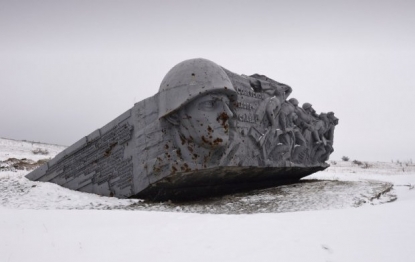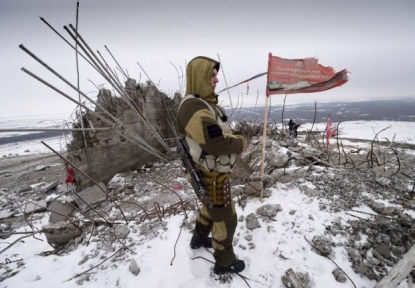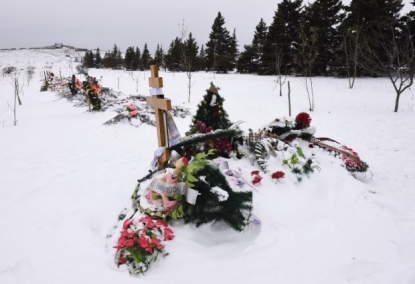Dead soldiers in the snow
(AFP Photo / Eric Feferberg)
SAVUR-MOGYLA, Ukraine, December 9, 2014 - It was bitterly cold on the hilltop, with an icy wind whipping up gusts of snow.
We had come here to see an Orthodox religious icon, brought here for the day in memory of the pro-Russian rebels killed in this part of eastern Ukraine.
Families of the fallen fighters were there along with two dozen separatist rebels, about 60 people in all, come to worship the icon and honour their dead.
The ceremony was held in the midst of the vast Savur-Mogyla memorial to the thousands of Soviet and German troops killed fighting over the strategic height during World War II.
 Recent damage at the Savur-Mogyla World War II memorial (AFP Photo / Eric Feferberg)
Recent damage at the Savur-Mogyla World War II memorial (AFP Photo / Eric Feferberg)It’s a truly Dantean complex, spread over an entire hillside a few miles from the Russian border, that was partly destroyed in fighting between Ukrainian government troops and separatists in July and August – changing hands several times over the summer.
What remains standing is riddled with bullets. Three colossal, pale grey cast iron blocks, with giant soldiers’ faces staring out across the snow - now strafed with rust-coloured holes.
 The Savur-Mogyla World War II memorial (AFP Photo / Eric Feferberg)
The Savur-Mogyla World War II memorial (AFP Photo / Eric Feferberg)At the top of the hill there used to be an even bigger monument, a 30-metre obelisk with the statue of a Soviet soldier raising his rifle above his head. It has been reduced to rubble.
The whole complex is littered with scraps of shell and cast iron.
Being there, you had both a sense of beauty and nostalgia, and of utter desolation. It's a stark reminder of the violence of the fighting between Ukrainian government forces and rebels.
 A Donetsk People's Republic fighter looks out over the damaged Savur-Mogyla memorial (AFP Photo / Eric Feferberg)
A Donetsk People's Republic fighter looks out over the damaged Savur-Mogyla memorial (AFP Photo / Eric Feferberg)At the foot of the 1960s monument, several hundred metres below, there are frescoes depicting the series of long and bloody battles for the height in August 1943, when Russian troops beat off soldiers from Nazi Germany. Names of thousands of the dead are inscribed alongside.
Pro-Russian fighters killed in the area have been buried at the foot of the memorial. The separatists and their sympathisers have a deep nostalgia for Communist times – and this is a powerful symbolic site in their collective memory.
For Ukraine's separatists, the memorial near their stronghold of Donetsk also serves to reinforce the notion that their insurgency is directed against "fascist" invaders from Kiev.
 The graves of Donetsk People's Republic fighters near the Savur-Mogyla memorial (AFP Photo / Eric Feferberg)
The graves of Donetsk People's Republic fighters near the Savur-Mogyla memorial (AFP Photo / Eric Feferberg)For the ceremony they dug a hole at the bottom of the hill to bury an old miner’s lamp, containing papers belonging to fallen fighters. Then they fired shots shot into the air in honour of the dead.
They were gathered there for several hours, with locals waiting in the icy wind for a chance to kneel down before the icon of the Holy Virgin of Tikhvin, brought here for the day from Moscow.
The Russian Orthodox relic has an incredible story. There are several versions, the oldest dating back to 1383. This one dates from 1803 and is said to have been present at the 1812 Battle of Borodino against Napoleon’s troops.
In 1941, during World War II, the relic overflew Moscow on a plane to protect the city from a Nazi invasion.
Today the icon is ferried from site to site to whip up support for the Russian fight against “fascists", as the Kremlin labels Ukraine's pro-Western camp.
Eric Feferberg is an AFP photographer based in Paris. He travelled to eastern Ukraine for three weeks in late November and early December 2014.
 Donetsk People's Republic fighters fire in the air at the Savur-Mogyla memorial in eastern Ukraine (AFP Photo / Eric Feferberg)
Donetsk People's Republic fighters fire in the air at the Savur-Mogyla memorial in eastern Ukraine (AFP Photo / Eric Feferberg)

